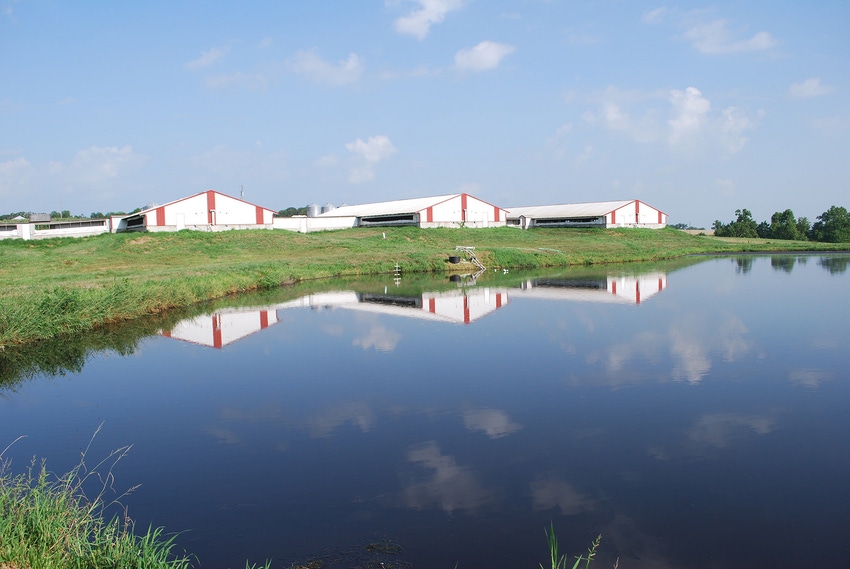In lagoon systems, often the manure is diluted to help it flow better, but this dilution also helps the lagoon be more aerobic, at least at the surface.
December 7, 2022

Manure is stored with one surface in contact with the atmosphere. That atmosphere contains oxygen. Shouldn't this oxygen diffuse into the manure and make it aerobic? And the truth is it does, but often the diffusion rate is low compared to the rate at which oxygen in the manure is consumed.
As a result, the manure will still be anaerobic. In this article, we'll look at oxygen diffusion into the manure and discuss the impact manure strength and the amount of organic matter in the manure has on how much of the manure is aerobic.
This analysis is simplified because it doesn't account for surface disturbance from wind or mixing in the manure that might spread oxygen around. That is to say, it is primarily for illustrative purposes and to get a feel for anaerobic manure storage conditions.
This analysis works down to two parts understanding oxygen movement through the manure and the destruction, or use of that oxygen, to consume organic material. The first part relies on Fick's law to understand how oxygen moves in manure. It should be noted that this is based on no mixing. Mixing drastically changes oxygen movement as it allows for advection, mixing with the movement of the manure, and diffusion.
To get an estimate of just diffusion-driven oxygen movement in manure, though, I did have to make a couple of assumptions. The first is that there is a small layer of manure at the surface with an oxygen content always in equilibrium with the atmosphere. The second is Fick's Law and the oxygen diffusion rates in water, which describe the movement of oxygen in manure.
The oxygen content of the surface water is estimated using Henry's Law and assuming Henry's constant of KH = 4.34 x 104 atm @ 77°F (25°C). Accepting a partial pressure of 0.21, based on the 21% oxygen content of the atmosphere, gives, 4.84 x 10-6 moles of oxygen in a mole of water or 4.84 x 10-6 moles of oxygen in 18 g. And after a little rearranging and a unit conversion, this amounts to, 4.3 mg/L.
Using this information, Fick's Law can be used to estimate diffusion. The oxygen diffusion rate in water at 77°F (25°C) is 2.42 x 10-9 m2/s. The rest of the equation represents the change in concentration over distance. The change in concentration is 4.3 mg/L since we know the concentration is at a maximum at the surface and goes to zero, but we aren't sure over what distance this will occur yet. To help get an estimate of the distance, we need to think about how quickly the oxygen will be used.
Chemical oxygen demand is often measured on different wastewater materials, including manures, to help understand the strength of the material. The typical COD of deep pit swine manure is around 100,000 mg/L. About 25% of this will often be BOD5 (the amount of oxygen bacteria will consume in five days as they break down organic matter) or 25,000 mg/L. Assuming that 1/5th of the oxygen will be broken down daily, 5,000 mg/L of oxygen will be consumed.
The solution becomes iterative as we try to guess the depth that causes all the oxygen to be depleted. To start, assume a 1 m x 1 m x 1 m deep chunk of liquid manure. The diffusion of oxygen can then be calculated as 0.9 mg/m2-day.
How does this compare with the oxygen demand of the manure? That 1 m x 1 m x 1 m chunk of manure has a 1-day BOD of 5,000,000 mg. Suppose you take the 0.9 mg/m2day/ 5,000,000 mg/m3day= 0.00000018 m. This gives us our first guess of the depth. The smaller depth will cause a much higher diffusion rate and lower oxygen demand. We want to keep iterating this depth process until we find a consistent depth.
If we iterate this solution, we will find that the depth to which oxygen diffuses is 5.6 mm.
Now iterate the depth you selected in the diffusion equation until it matches the depth of extinction
The diffusion depth of oxygen into manure is 0.42 mm or about 0.02 inches. More than that, that oxygen consumed a tiny amount, 0.00002%, of the oxygen demand.
In lagoon systems, often the manure is diluted to help it flow better, but this dilution also helps the lagoon be more aerobic, at least at the surface. Let's see what happens if the manure is diluted by a factor of 5. In this case, about 1 mm would have oxygen or 0.04 inches. Even in this case, diffusion alone has a limited impact on making the manure aerobic. To help with this, lagoons often have residual material left in them to help further dilute the manure and to help improve oxygen transfer by providing a larger surface area. In addition, wave action from wind or surface aerators or often necessary to make the lagoon aerobic.
So manure is anaerobic because it has a high capacity to consume oxygen relative to how quickly diffusion allows oxygen to move through the manure.
Source: The Manure Scoop is written by Anderson and brought to you by Iowa State University Extension and Outreach.
You May Also Like



